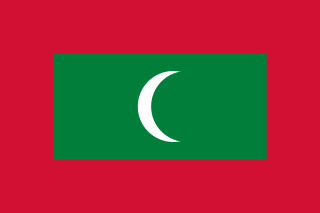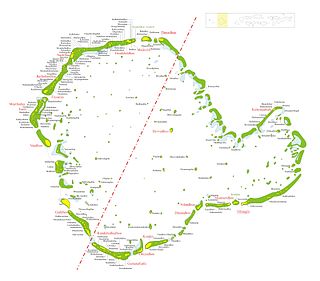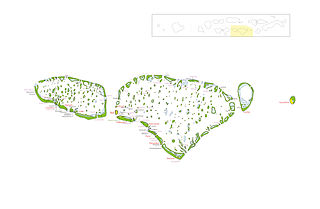
The Maldives, officially the Republic of Maldives, is a small island nation in South Asia, located in the Arabian Sea of the Indian Ocean. It lies southwest of Sri Lanka and India, about 1,000 kilometres (620 mi) from the Asian continent. The chain of 26 atolls stretches from Ihavandhippolhu Atoll in the north to Addu Atoll in the south. Comprising a territory spanning roughly 298 square kilometres (115 sq mi), the Maldives is one of the world's most geographically dispersed sovereign states as well as the smallest Asian country by land area and population, with around 515,696 inhabitants. Malé is the capital and the most populated city, traditionally called the "King's Island" for its central location.

Huvadhu is a large atoll located south of the Suvadiva Channel the Republic of Maldives. Etymologically it was called Suvadhinmathi or Suvadiva, with a total area of 3152 km², of which 38.5 km² is dry land.

The Maldives are formed by a number of natural atolls plus atolls in the form of a few islands and isolated reefs today which form a pattern stretching from 7 degrees 10′ North to 0 degrees 45′ South.

Baa Atoll is an administrative division of the Maldives. It consists of three separate natural atolls, namely southern Maalhosmadulu Atoll, the Fasdūtherē Atoll and the smaller natural atoll known as Goifulhafehendhu Atoll.

Kaafu Atoll is the code name given to an administrative division in the Republic of Maldives which consists of the geographical atolls of Kaashidhoo Island, Gaafaru, North Malé Atoll and South Malé Atoll. As the two Malé Atolls are the main islands of the administrative district, the entire Kaafu Atoll administrative division is officially named Malé Atoll or Malé Atolhu in the Maldivian language, Dhivehi.

Alif Alif Atoll is an administrative division of the Maldives. It was created on March 1, 1984, combining northern section of Ari Atoll, the small Rasdhukuramathi Atoll, and the isolated island of Thoddoo. Many of the islands in this atoll have been inhabited since ancient times and have archaeological remains from the Maldivian Buddhist period.

Alifu Dhaalu Atoll is an administrative division of the Maldives.

Vaavu Atoll is an administrative division of the Maldives comprising the natural atolls of Felidhu Atoll and the Vattaru Reef.

Gaafu Alifu is an administrative division of the Maldives created on February 8, 1962 when Huvadhu Atoll was divided into two districts. Gaafu Alifu corresponds to the northeastern section of this large natural atoll north of the line extending between the channels of Footukandu and Vaarulu Kandu. The capital of this district is Vilingili.

Gaafu Dhaalu is an administrative district of the Maldives formed by the southwestern section of Huvadhu Atoll. It was created on February 8, 1962 when Huvadhu Atoll was divided into two districts. Gaafu Dhaalu corresponds to the Southwestern section of this large natural atoll, south of the line extending between the channels of Footukandu and Vaarulu Kandu. The capital of this region was Vaadhoo but it has been changed to Thinadhoo. There are 153 islands in this district, 10 of which are inhabited. This district is located about 340 kilometres south of the capital Malé.

Addu Atoll, also known as Seenu Atoll, is the southernmost atoll of the Maldives. Addu Atoll, together with Fuvahmulah, located 40 km north of Addu Atoll, extend the Maldives into the Southern Hemisphere. Addu Atoll is located 540 km south of Malé, the country's capital. Administratively, Addu Atoll is the location of Addu City, one of the two cities of the Maldives. Addu City consists of the inhabited areas of Addu Atoll, namely the natural islands of Hulhudhoo, Meedhoo, Maradhoo, Feydhoo, and Hithadhoo.. In addition to the areas that are included as a part of Addu City, Addu Atoll has a number of other inhabited and uninhabited islands, including the island of Gan, where Gan International Airport is located.

The United Suvadive Republic or Suvadive Islands was a short-lived breakaway nation in the remote southern atolls of the Maldive Islands that constitute the Suvadive archipelago.
Narizlandia is a group of natural atolls in the Republic of Maldives.
Kardiva Channel is a broad channel running from southwest to northeast and cutting across the Maldive atoll chain. This channel divides the Northern from the Central atolls of the Maldives.
Koimala Siri Mahaabarana Mahaa Radun or Koimala or Koimala Kalo is the last pre-Islamic and the earliest verifiable ruler of the Maldives. He reigned from A.D. 1117 to A.D. 1141. According to the Isdhoo Loamaafaanu, he unified the whole of the Maldives from Minicoy to Addu in the south under his rule. Local folklores claim that he was the first Muslim ruler, however it is his successor Dhovemi of the Maldives who converted to Islam in 1153.
There are broad channels between the Atolls of the Maldives known locally as 'kandu'. The deepness and broadness of the channels vary from channel to channel.
Kaashidhoo Kuda Kandu is a channel in the Maldives. Since the island of Kaashidhoo is located in the midst of the Kaashidhoo Kandu, or Kardiva Channel it is often referred to as having two parts with Kuda Kaashidhoo Kandu as the channel south of Kaashidhoo island.
A channel in the Maldives. Since the island of Kaashidhoo is located in the midst of the Kaashidhoo Kandu, or Kardiva Channel it is often referred to as having two parts. Kaashidhoo Bodu Kandu is the part between of Lhaviyani Atoll Aligau and Gaafaru Falhu.

Kuruhinna Tharaagandu is an archaeological site 2–4 hours from Malé, in the island of Kaashidhoo, Maldives. The site is a Buddhist Monastery and is believed to have been used by pre-Islamic Maldivians dating back to the 7th to 8th century AD. The excavation work was done in various periods from February 1996 through 1998. During this period, an area of 1,880m2 was excavated, revealing 64 coral stone structures. For the vast majority, only the lower most parts have been preserved.












